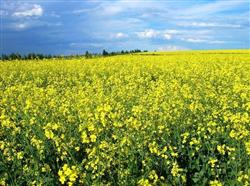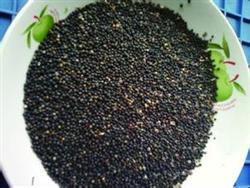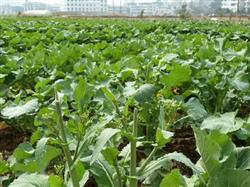Occurrence characteristics and control methods of rape weeds

1. The main species of weeds in Jiangsu Province are mainly winter-sown rape, but very few spring-sown rape. The occurrence of weeds in winter-sown rape field is basically the same as that in wheat field, and there are two kinds of dry land stubble and rice plate stubble in the previous stubble. The main weeds of rape in dry stubble are: porcine calamity, wheat kernel bead, mother-in-law, Chenopodium, Artemisia annua, shepherd's purse, orchid, Cardamine, Kentucky bluegrass, wild oat, flat storage, wheat bottle grass, prickly cabbage, small spiral flower and so on. The harm of wild oats in some areas is serious. The main weeds of oilseed rape in rice stubble are Niangmai, Niangmai, hard grass and Kentucky bluegrass, while other weeds are clam grass, pig calamity, Niufan wisp, broom grass, big nest vegetable, Cardamine cardamine, shepherd's purse, mother-in-law, rice Croucher and so on. Spring sowing rape field, the main weeds are wild oat, quinoa, flat, borage, big thorn, Polygonum curly, pig calamity, ion grass, Elsholtzia splendens, weasel petal, amaranth, barnyardgrass, thin capsule grass, bauhinia and so on, of which wild oat is the most harmful. The number of weeds in rice stubble field is more than that in dry stubble field. Second, the occurrence characteristics of rape cultivation methods are direct seeding rape and transplanting rape, and there are two tillage methods: board stubble sowing and ploughing and ploughing, and the occurrence of weeds in the field is also significantly different. The seedling stage of transplanting rape is mainly to look at Mai Niang, clam grass, mother-in-law and wisp, the peak of hair is at 7-10 days after sowing, the symbiosis period with rape is shorter, and the rape seedling density is high, the growth is fast, and the grass damage is light. The occurrence characteristics of weeds in rape fields sown and replanted in winter were similar to those in wheat fields sown at the same time. The hay peak appeared at 10-30 days after sowing, and the amount of grass was large in this period, which was the main weed population in rape field. The main weeds sprouting in dry land stubble are broad-leaved weeds, and the grass yield is relatively small, while the weeds sprouting in rice stubble are mainly Gramineae weeds, and the grass yield is more. In the rape field planted with winter sowing board, because the soil surface outside the sowing hole (row) was not destroyed, the soil surface weed seeds germinated before sowing and formed an early weed community in the field, and the topsoil was destroyed during sowing and transplanting. The germination peak of weeds germinated in the sowing hole (row) and upturned soil layer appeared at 10-30 days after sowing. Due to the vigorous growth and fast growth rate of rape fields after spring, only a few weeds such as big nest cabbage, pig calamity, wild oat and so on can have a great impact on rape production, and most of them die out naturally because of the shade of rape plants. Except for a few late sowing and late planting fields with poor growth of rape, the weeds sprouting in the field in spring have little effect on rape and can not be treated. 3. Control technology for the control of weeds in rape field, on the basis of the application of various agricultural measures, according to the planting mode of rape and the main community characteristics of weeds in rape field, the suitable varieties and formulations of herbicides should be selected, focusing on the control in autumn and winter. 1. Pre-seedling removal after seeding in seedling bed or direct seeding field due to the short damage time of weeds and the easy formation of seedling population advantage, it is only necessary to ensure the safe growth of vegetable seedlings in the early stage. Therefore, 60% butachlor EC 75 kg 120 ml, 50% alachlor EC 200 ml 250 ml or 48% alachlor EC 200 ml 250 ml can be selected, and 40 kg of water can be manually sprayed with 45 kg of water to prevent rape before seedling after sowing. two。 Chemical stubble killing before sowing should be used to control or regenerate plants from the previous crop before sowing and the weeds that have germinated in the field after the previous crop harvest. You can choose 41% glyphosate water agent 100 kg 150 ml or 20 g Wuchuan (paraquat) EC 200g 250 ml, or similar agents to manually spray 30 kg of water. 3. Soil treatment during sowing period for rape fields dominated by Gramineae weeds such as Niangmai in Japan, 48% trifluralin EC 100ml 150ml can be applied and mixed with soil 3-5 days before sowing, or 65% Metolachlor 45ml 60ml, 48% Metolachlor EC 50ml or 50% Acetochlor EC 75ml 100ml before sowing, transplanting rape or the next day after planting. For rape fields mixed with Gramineae weeds, shepherd's purse, curly ear and other broad-leaved weeds, Duer or Guangmieling, or the mixture of propachlor and Guangmiling can be applied before sowing or planting of rape. 4. Post-seedling stem and leaf spray for rape fields dominated by Gramineae weeds, 10.8% high-efficiency cauliflower 20ml 30ml, 10% quizalofop EC 35ml 50ml, 6.9% Weiba (oxazolidin) EC 40ml 50ml, etc. the weeds were controlled before the 4-leaf stage. For fields mainly composed of small nest vegetables, Artemisia annua, Croucher vegetables, mud paste vegetables, wild geranium, etc., 50% Gaoteke (herbicide) suspension 30ml 40ml or 33% herbicide (pendimethalin) EC 50ml can be used to spray 40kg of water in autumn and winter. For the fields mainly composed of hard grass and Kentucky bluegrass, 24% enoxone EC 20ml / mu can be used to control weeds at the stage of 3 leaves and 4 leaves.
- Prev

Use rape without a trace before sowing.
20% grams of water-free agent is a contact-killing herbicide. Spraying Ke after no-tillage direct seeding or transplanting rape during harvest and stubble of rice and cotton can improve soil fertility, improve soil structure, increase permeability, preserve fertilizer and water, and save labor and cost compared with ploughing and planting rape, especially in rural areas.
- Next

How to prevent rape Fertilizer damage
1. To reform the fertilization method in accordance with the principle of practicality, practicality and effectiveness, the compost and mature organic fertilizer made by retting with enzyme bacteria are recommended, and the method of layered application or deep application of the whole layer is adopted. According to the planned stubble and the total amount of fertilizer in the current year, it can be applied at one time during deep ploughing, and the formula fertilization technology can be adopted to master the three elements of nitrogen, phosphorus and potassium.
Related
- The first cup of black tea in spring, the flavor and history of tea gardens in Kenya, Africa
- The computer can not only choose potatoes, but also grow tea rice. AI will grow winter oolong tea champion.
- It is not only the inflated tea bitten by insects, but also engraved with the four seasons tea in Beipu.
- The Oriental Beauty Tea Festival in Zhuxian County takes the stage at the weekend to experience the plus-size feast of oil tea.
- & quot; Oriental Beauty Tea & Exploration of Emei in Hsinchu, the hometown of quot;
- The new variety of strawberry "Tainong 1" dessert is the first choice with mellow aroma. Crimson gorgeous
- History of Tea in Taiwan: from Wild Inner Mountain to Export Tea Garden
- Two types of Taiwan Oriental Beauty Black Tea won the British three-Star Award for Childhood Tea Xiang Zhang Jiaqi changed from pilot to champion tea maker.
- Banana species and varieties: the planting history of Taiwan Xianren banana and dwarf banana is long, is banana disease resistant?
- Coffee planting Technology: Qianjie Coffee from Seedling to harvesting

